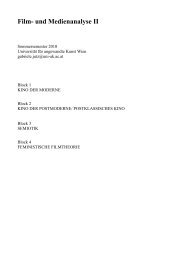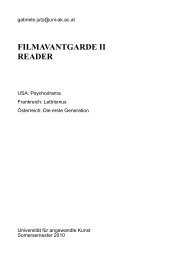Filmanalyse - Gabriele Jutz
Filmanalyse - Gabriele Jutz
Filmanalyse - Gabriele Jutz
Create successful ePaper yourself
Turn your PDF publications into a flip-book with our unique Google optimized e-Paper software.
108 Tom Gunning<br />
— the chase film. In this genre the disruption of the cut is naturalized by<br />
a continuity within the story. Specifically this continuity is the actual<br />
movement of a character(s) that bridges the cuts. The end of one shot is<br />
signalled by characters leaving the frame, while the next shot is inaugurated<br />
by their reappearance. The disruption of the cut is, as it were,<br />
smoothed over by the continuity of the character's movement and the<br />
brief ellipsis of his action between shots is minimized rather than<br />
emphasized. We find proto-types of this sort of continuity in early<br />
multi-shot narratives, such as Méliès' A Trip to the Moon* (1902), in<br />
which the tableaux form is modified by the departure from one location<br />
at the end of the shot and their arrival in the next locale in the following<br />
shots (not to mention the fully developed continuity of the sequence of<br />
the rocket's return to earth in Melies' films)/13. But this form of<br />
continuity finds its complete expression in the chase film, in which the<br />
action of dashing from one locale to the next provides the narrative<br />
armature of the film.<br />
Although there are proto-types of the chase form from as early as<br />
1901 (Williamson's Stop Thief!*), it becomes an important form about<br />
1904 with such films as Biograph's The Maniac Chase* and Personal*.<br />
These films form a sort of template from which an enormous series of<br />
imitations and variations are produced over the next four years. The<br />
pattern is consistent : a character is chased by a group of characters<br />
from one location to the next, with each shot showing the character<br />
being chased at some distance from the pursuing mob, the shot held<br />
until first the pursued and then the pursuers exit from the frame. The<br />
next shot begins this movement through the frame over again. This<br />
continues until at some fairly arbitrary point the fleeing figure is<br />
captured. This form of narrative was extremely popular and appears in<br />
a large number of films. Its dominance is undoubtedly overdetermined,<br />
but its mastery of the problem of the disruption of the cut through a<br />
narrative continuity shows the way a genre responds to a formal issue<br />
raised by preceding genres.<br />
The approach to continuity established by the chase film also allows<br />
a series of variations in which continuity of action over a series of cuts<br />
establishes a coherent synthetic geography. Films such as Rescued by<br />
Rover* (Hepworth, Great Britain, 1905) are examples of this as is a sort<br />
of sub-genre of the narrative of continuity in which the gags of the<br />
single shot narratives are concatenated along the trajectory of a single<br />
character. These films present a series of linked vignettes as a character<br />
sets off a series of comic disasters along his route, as in Hepworth's<br />
That Fatal Sneeze (Great Britain, 1907), in which a man doused with<br />
/ 13. See Gaudreault, op. cit.<br />
Non-Continuity. ntinuity. Discontinuity<br />
Rescued by Rover (Hepworth. 1905).<br />
pepper by a mischievous child causes disorder as he sneezes explosively<br />
in a succession of locales. Films of this sort appear particularly frequently<br />
in 1907 and may signal a recognized need for variation from the<br />
chase format and the decline of the genre of continuity.<br />
The fourth genre, the narrative of discontinuity, refers to the reintroduction<br />
of the disruption of the cut into situations similar to the<br />
chase form. This disruption on the level of plot rather than story comes<br />
with the introduction of parallel editing and its locus c/assicus is the last<br />
minute rescues found in the Biograph films of D.W. Griffith. The<br />
appearance of parallel editing represents a particularly important juncture<br />
in the history of early film for a number of reasons, not the least of<br />
which is its specification of temporal and spatial relations between<br />
shots. But in the context of the succession of genres it can be seen as a<br />
dialectical response to the genre of continuity represented by the chase<br />
film. The earliest clear examples of parallel editing appear around 1907<br />
in such films as The Runaway Horse (Pathe, 1907) and The Hundred to<br />
One Shot (Vitagraph, 1906). Although there may be earlier examples,<br />
they remain too infrequent to signal anything other than the prototypes<br />
of a genre. It is only in 1908 and 1909 that a large number of films<br />
appear that make use of this editing pattern.





![+ [R] - Gabriele Jutz](https://img.yumpu.com/7473913/1/190x245/-r-gabriele-jutz.jpg?quality=85)
![+ [R] - Gabriele Jutz - Sonance.net](https://img.yumpu.com/5987492/1/184x260/-r-gabriele-jutz-sonancenet.jpg?quality=85)